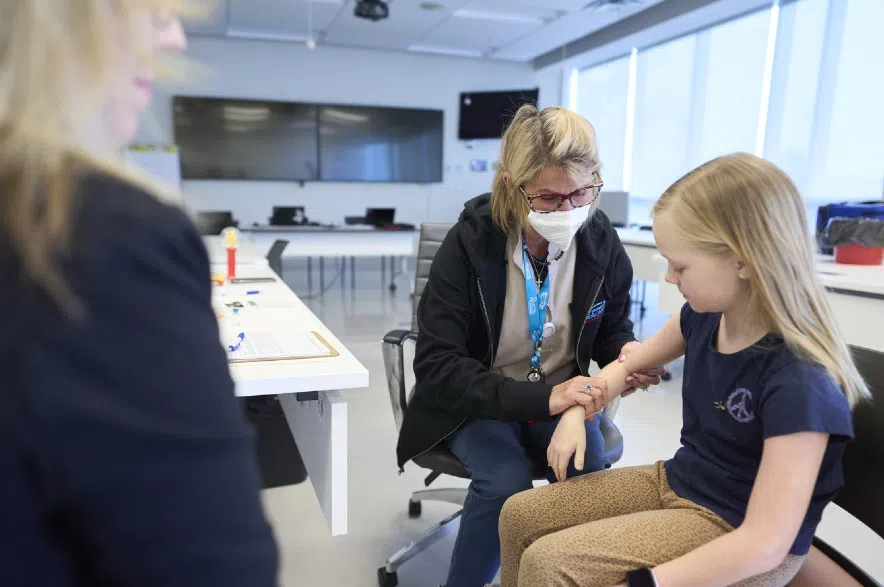A measles exposure risk in Kindersley has prompted a warning from Saskatchewan Health Authority (SHA).
SHA said in a news release on May 13 that anyone who was at Cameron’s Clothing Company store at 705 11 Ave E on May 5 and 6 from 10 a.m. to 8 p.m., May 7 from 10 a.m. to 7 p.m. and May 9 from 10 a.m. to 8 p.m.; and inside the pro shop at Kindersley Regional Park & Golf Course at 1 Ditson Drive on May 7 from 5:30 p.m. to 7:30 p.m. should monitor for measles symptoms for up to 21 days after exposure.
Read more:
- Saskatoon sees 30 overdoses in three days, prompting health ministry warning
- ‘Shortage of paramedics entering EMS as a career in Sask.’: SHA
- Sask. children’s hospital nurse fired after snooping on 314 patients
On May 9, the SHA notified the public that there was also a risk of exposure to the virus in Regina, Lumsden, Saskatoon, and Rosetown. It listed Kindersley as well, but gave no locations.
In Regina, anyone who was at Ellis Pools and Construction at 1135 Pettigrew Avenue on April 29, April 30, May 1, May 2 and May 8 from 9 a.m. to 7 p.m. as well as Jesus The Anointed One Church at 41 Birchwood Road on May 4, from 1 p.m. to 5 p.m. may have been exposed to the potentially serious virus, the SHA said in a news release on May 9.
In Lumsden, people who were at Subway at the Esso C-Store on Highway 20 on May 3 from 2 p.m. to 6 p.m., are also at risk, the SHA said.
In Saskatoon, anyone who was at the Scotiabank on Kensington Boulevard on May 3 between 10 a.m. and 12:30 p.m. or the Walmart on Betts Avenue on the same day from 10:15 a.m. to 12:30 p.m. was asked to monitor themselves for symptoms.
The exposure risk also applies to anyone who was at the Rosetown Hospital on May 4 (8:45 p.m. to midnight), May 5 (midnight to 1:30 a.m., and 9:15 a.m. to 11:15 a.m.), May 6 (3:30 a.m. to midnight) and May 7 (midnight to 3:20 p.m.).
Similar warnings have also been issued for Preeceville, Rosthern and Regina.
The Saskatchewan government has not updated its measles cases online since May 7, when it said there were 27.
What are the symptoms of measles?
The SHA said that the symptoms of measles include fever, cough, runny nose, red eyes, fatigue, irritability (feeling cranky or in a bad mood), small, white spots (known as Koplik spots) inside the mouth and throat, and a red blotchy rash which develops on the face and spreads down the body about three to seven days after symptoms begin and can last four to seven days.
The SHA said anyone who has any of the listed symptoms and was at any of the listed locations during the identified times, should call HealthLine811, their primary care doctor or nurse practitioner.
Anyone in medical distress, should go to an emergency room or call 911, and identify they may have been exposed to measles.
The health authority also said that measles can be prevented by the safe, effective and free measles vaccine and with two doses, the vaccination is almost 100-per-cent effective.
“Immunization is your best tool against measles, and two complete doses is what you need to have full vaccination. One dose is not enough,” the SHA’s Dr. David Torr said recently.
“Once immunized, the measles vaccine is extremely efficient, over 90 per cent of protection both against actually getting the infection and certainly against getting any complications or even death from measles.”
The second dose is especially important for people born in or after 1970.
Measles is spreading worldwide and the World Health Organization has expressed concerns.
“Get yourself up to date with the immunizations,” Torr said. “Otherwise you’re not properly protected against measles — and it is here.”
To check your vaccination records, Torr said to check MySaskHealthRecord, and if you can’t find anything there to contact public health.
Why is measles dangerous?
Measles is highly contagious and can spread very easily by breathing contaminated air after an infected person coughs or sneezes, or by touching a contaminated surface such as a doorknob or a shopping cart.
In rare cases can lead to respiratory failure, swelling of the brain and death.
If anyone breathes the contaminated air or touches a contaminated surface and then touches their nose, eyes or mouth, they can become infected.
The virus can live up to two hours in the air or on surfaces in a space where an infected person coughed or sneezed.
It can spread to others from four days before a rash appears until four days after a rash develops. Through this period, people need to stay in strict isolation to avoid spreading the infection.
— with files from Canadian Press
Editor’s Note: This story has been updated to amend the date of the exposure risk in Kindersley, following a correction issued by the Saskatchewan Health Authority.











